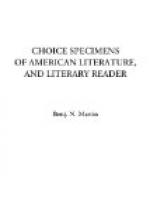“There is but one word more to add,” he murmured softly, as he bent towards her—
A grave voice interrupted him. “Excuse me, Mr. Bradshaw,” said Master Byles Gridley, “I wish to present a young gentleman to my friend here. I promised to show him the most charming young person I have the honor to be acquainted with, and I must redeem my pledge. Miss Hazard, I have the pleasure of introducing to your acquaintance my distinguished young friend, Mr. Clement Lindsay.”
* * * * *
From “Currents and Counter Currents.”
=_214._= MECHANISM OF VITAL ACTION.
But if the student of nature and the student of divinity can once agree that all the forces of the universe, as well as all its power, are immediately dependent upon its Creator,—that He is not only omni_potent_ but omni_movent_,—we have no longer any fear of nebular theories, or doctrines of equivocal generation, or of progressive development....
We begin then by examining the general rules which the Creator seems to have prescribed to His own operations. We ask, in the first place, whether He is wont, so far as we know, to employ a great multitude of materials, patterns, and forces, or whether He has seen fit to accomplish many different ends by the employment of a few of these only.
In all our studies of external nature, the tendency of increasing knowledge has uniformly been to show that the rules of creation are simplicity of material, economy of inventive effort, and thrift in the expenditure of force. All the endless forms in which matter presents itself to us, are resolved by chemistry into some three-score supposed simple substances, some of these perhaps being only modifications of the same element. The shapes of beasts and birds, of reptiles and fishes, vary in every conceivable degree; yet a single vertebra is the pattern and representation of the framework of them all, from eels to elephants. The identity reaches still further,—across a mighty gulf of being,—but bridges it over with a line of logic as straight as a sunbeam, and as indestructible as the scymitar-edge that spanned the chasm, in the fable of the Indian Hades. Strange as it may sound, the tail which the serpent trails after him in the dust, and the head of Plato, were struck in the die of the same primitive conception, and differ only in their special adaptation to particular ends. Again, the study of the movements of the universe has led us, from their complex phenomena, to the few simple forces from which they flow. The falling apple and the rolling planet are shown to obey the same tendency. The stick of sealing-wax which draws a feather to it, is animated by the same impulse that convulses the stormy heavens. These generalizations have simplified our view of the grandest material operations, yet we do not feel that creative power and wisdom have been shorn of any single ray, by the demonstrations of Newton, or of Franklin.




